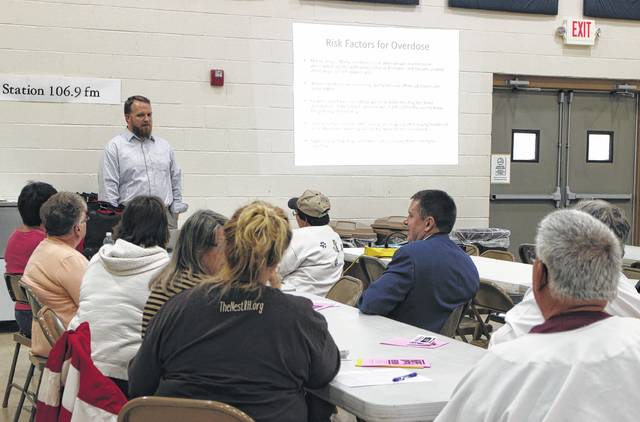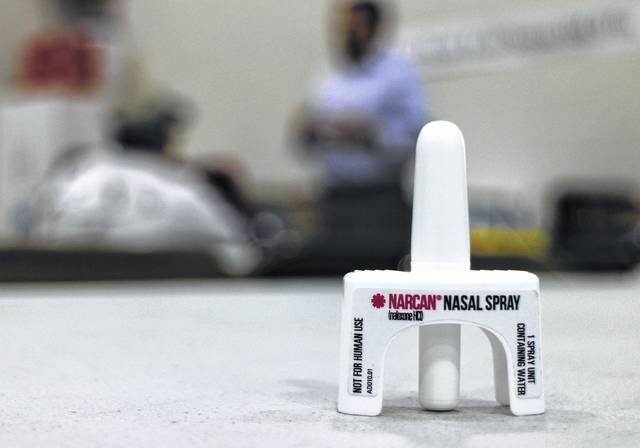

About a dozen people showed up to St. Mary Catholic Church Thursday evening to receive free Narcan kits containing two doses of naloxone nasal spray, a pair of latex gloves and an informational pamphlet with treatment center information.
The kits, assembled by Project DAWN (Deaths Avoided With Naloxone) are funded through a grant from Interact For Health and distributed by REACH for Tomorrow in partnership with the Highland County Health Department.
Highland County Health Commissioner Jared Warner said allowing public access to the life-saving opiate blocker is the right thing to do, “even if we catch flak for it.”
Narcan, a marketed version of the opiate blocker naloxone, has proven to be controversial in public discussion of the opiate epidemic, and several public officials have expressed concern about public access to the drug.
Warner has said people who receive the kits are recorded, but that information can’t be shared without a legal order.
“We are required by law to maintain a list of who we provide the medication to,” he said, “but… it is considered protected health information, so we’re not allowed to release it… If (law enforcement officials) need it for a court case, they would need to follow the legal process just like getting patient information.”
Highland County Sheriff Donnie Barrera, Paint Creek Joint EMS/Fire District Chief Bradley George and Highland County Prosecutor Anneka Collins have previously expressed varying opinions on public access to Narcan and whether it would be a good thing, but they agreed there should be some type of accountability for those who obtain it.
A number of community members have raised concerns about Narcan giveaways being used as part of so-called “Narcan parties,” where someone serving in a role akin to a “designated driver” is on hand with Narcan while others engage in drug use. The sheriff has said that while he had heard such stories, he was not aware of those activities in Highland County, and Warner said those tales are “a misconception.”
The sheriff said that establishing a system of responsibility for obtaining Narcan would be a good step.
“I’m all for the public getting Narcan,” Barrera told The Times-Gazette previously. “The only thing I worry about is law enforcement not knowing who has it, and not knowing if somebody uses the stuff or not. I hope they can have something set up to see if it’s used and reported, something like Sudafed where they have to sign it out… There ought to be some accountability. Who they’re giving it to, and if they know it’s a known user coming in to get it, that needs to be recorded… and given to the proper people.”
Paint Creek’s George also said accountability is important to make sure authorities are aware of who has Narcan.
“People have to be accountable,” he said.
Collins said some type of registration should be necessary for identifying people who need help fighting addiction – whether they’re a concerned family member or an addict themselves.
“I think it’s good that you can save someone’s life, but on the other hand, there ought to be a way to track it,” Collins said. “Narcan is a very, very short-term fix for a serious problem… How are we going to track it and see who needs help?”
Warner has said he feels if there’s a way to stop deaths from happening, it’s his duty to make sure it’s available no matter what.
“These are real people, with real families, and they are a part of our community,” he said.
Warner, who led the training Thursday evening, gave participants a brief overview of the opiate epidemic, described the symptoms of overdose and showed a training video illustrating the best way to administer Narcan.
Warner stressed the importance of calling 911 first when someone observes an overdose, referencing rural areas of the county and consequentially lengthy emergency response times.
“Where we live, call 911 first,” he said.
Warner described the symptoms of an overdose, saying victims often breathe very lightly or infrequently, and sometimes make gurgling noises on inhalation.
“That’s when you say, ‘Oh, I have my handy-dandy Narcan kit,’” he said.
The Narcan in the Project DAWN kits is meant to be administered through one nostril, Warner said, and it generally takes one or two doses to fully revive someone experiencing an overdose.
Warner said overdose victims should be rolled onto their side after the Narcan is administered so if they vomit, and so it won’t go back down in their throat.
“They may go into immediately feeling terrible,” he said, describing symptoms such as diarrhea, urination and headaches occurring after the person wakes up.
After watching the training video, the participants were each given a Narcan kit.
Those interested in obtaining Narcan can call the health department at 937-393-1941, or REACH for Tomorrow at 1-877-997-3224.
Reach David Wright at 937-402-2570, or on Twitter @DavidWrighter.



